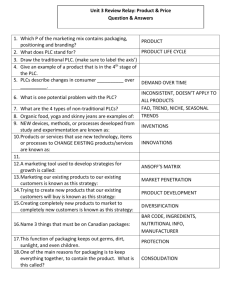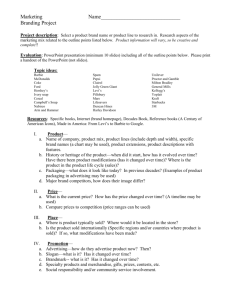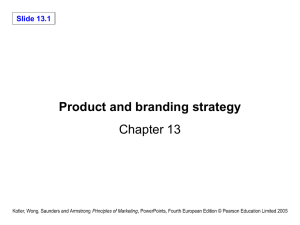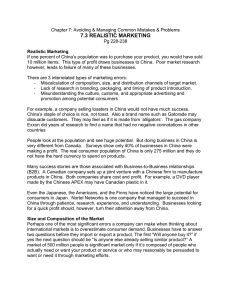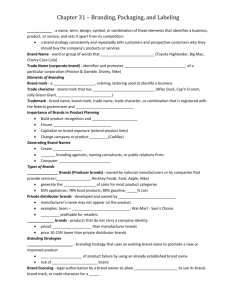Solomon_ch09_basic
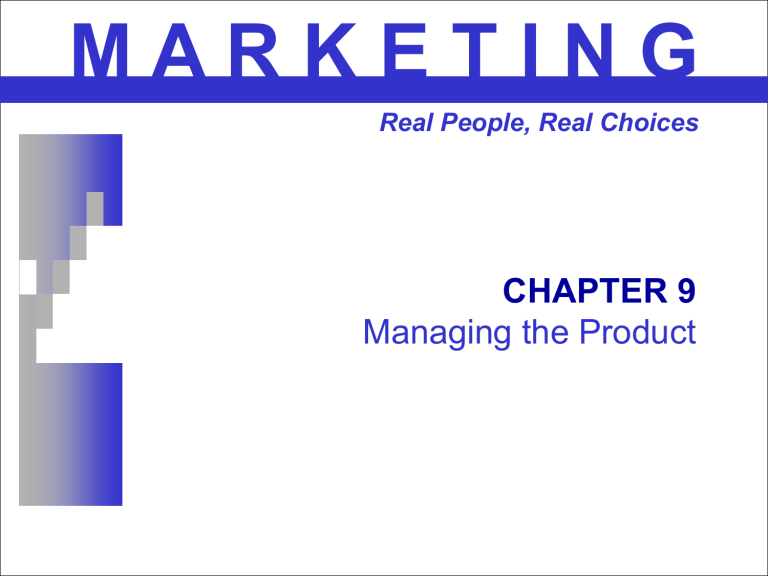
M A R K E T I N G
Real People, Real Choices
CHAPTER 9
Managing the Product
Chapter Objectives
• Explain the different product objectives and strategies a firm may choose
• Explain how firms manage products throughout the product life cycle
• Discuss how branding creates product identity and describe different types of branding strategies
9-2
Chapter Objectives
• Explain the roles packaging and labeling play in developing effective product strategies
• Describe how organizations are structured for new and existing product management
9-3
Steps in Managing Products
• Develop product objectives
• Individual products
• Product lines
• Design a product strategy
• Make tactical product decisions
• Branding
• Packaging/labeling
9-4
Criteria for Effective Objectives
• Measurable
• Clear
• Unambiguous
• Time-framed
• Consistent with long-term health of organization
9-5
Sample Product Objectives
• In the upcoming fiscal year, modify the product’s fat content to satisfy consumers’ health concerns
• Introduce three items to the product line to take advantage of increased consumer interest in Mexican foods
• During the coming fiscal year, improve chicken entrees such that consumers rate them as better tasting than the competition
9-6
Product Line Strategies
• A product line is a firm’s total product offering designed to satisfy a single need for target customers (e.g., P&G’s line of dish detergents: Dawn, Ivory, Joy)
• Possible line strategies:
– full line vs. limited line
– line stretch: upward, downward, or two-way
– filling-out vs. contracting
• Cannibalization?
9-7
Product Mix Strategies
• A product mix is a firm’s entire range of products (e.g., Gillette offers shaving products, deodorants, writing instruments, toothbrushes…)
• Strategic mix decisions usually relate to the width of the product mix - how many different product lines are produced by the firm
9-8
Quality as a Product Objective
• Product quality is the overall ability of a product to satisfy customer expectations
• Dimensions of product quality
– durability
– reliability
– precision
– ease of use
– product safety
– aesthetic pleasure
9-9
Quality Standards
• International Organization of
Standardization
– ISO 9000
– ISO 14000 (environmental)
• Six Sigma
9-10
Marketing Throughout the PLC
• The Product Life Cycle (PLC) explains how features change over the life of a product
• Marketing strategies must change and evolve as a product moves through the
PLC
• The PLC relates to a product category
9-11
Introduction – Product Life Cycle
• Full-scale launch of new product into marketplace
• Sales are low, high failure rate
• Little competition
• Frequent product modification
• Limited distribution
• High marketing & product costs
• Promotion focused on product awareness & to stimulate primary demand
• Intensive personal selling to retailers/wholesalers
9-12
Growth – Product Life Cycle
• Sales grow at an increasing rate
• Many competitors enter market
• Large companies may acquire small pioneering firms
• Profits are healthy
• Promotion emphasizes brand advertising & comparative ads
• Wider distribution
• Toward end of growth stage, prices fall
• Sales volume creates economies of scale
9-13
Maturity – Product Life Cycle
• Sales continue to increase but at a decreasing rate
• Marketplace is approaching saturation
• Typified by annual models of products with an emphasis on style rather than function
• Product lines are widened or extended
• Marginal competitors drop out
• Heavy promotions - sales promotions
• Prices & profits fall
9-14
Decline – Product Life Cycle
• Signaled by a long-run drop in sales
• Rate of decline is governed by how rapidly consumer tastes change or how rapidly substitute products are adopted
• Falling demand forces many out of market
• Few specialty firms left
9-15
Branding Decisions
• A brand is a name, term, symbol, or any other unique element of a product that identifies one firm’s product(s) and sets it apart from competition
• Brands should
– be memorable
– have a positive connotation
– convey a certain image
9-16
Good Brand Names
• Easy to say
• Easy to spell
• Easy to read
• Easy to remember
• Fit the target market
• Fit the product’s benefits
• Fit the customer’s culture
• Fit legal requirements
9-17
Packaging and Labeling Decisions
• Packaging functions
• Effective packaging designs
• Labeling regulations
9-18
Packaging Functions
• Protect the product
• Communicate brand personality
– Style, color, picture
• Provide specific information
– UPC Code, Warnings, Nutrition
• Make the package more user-friendly
– Easier to open
– Portability
9-19
Designing Effective Packaging
• How are competing brands packaged?
• How might the package enhance brand image?
• What possible environmental impact might the package have?
• How might package shape communicate brand image?
• What graphic information should the package show?
9-20


